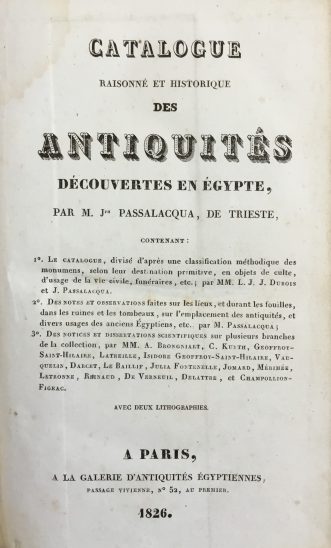Catalogue Raisonné et Historique des Antiquités Découvertes en Égypte.
Passalacqua, Giuseppe (Joseph) 1797-1865.
Synopsis
Giuseppe Passalacqua, or Joseph Passalacqua, was an Italian entrepreneur who specialised in trading and collecting ancient Egyptian artefacts. He was an amateur archaeologist who originally went to Egypt as a horse-dealer, but ended his days as conservator of the Egyptian Collections at the Berlin Museum. His excavations from 1822 to 1825 at Deir el-Bahri, on the west bank of Thebes, revealed the tombs of priests and priestesses of Amun. Further excavations in 1826 took him to the pyramids of Saqqara, where he discovered a number of important medical papyri. He had amassed a large and very important collection of antiquities, of which 1600 pieces were exhibited for sale at Galerie Vivienne in Paris, and this catalogue was produced to assist the sale. The importance of the collection is attested to by the distinguished scholars who produced the notes and scientific dissertations on the objects themselves. The collection was offered for sale to the French government, but was rejected, it was then bought by Frederick William IV, ruler of Prussia, for the Berlin Museum. Simultaneously Passalacqua was hired with an annual salary of 1000 Thaler (silver coins) and a personal allowance of 600 Thaler as the first director of the Egyptian collection, later part of the Royal Museum of Art and now the Egyptian Museum Berlin. He remained the conservator of the Egyptian collection till his death in 1865, when Karl Richard Lepsius, Passalacqua’s assistant at the Museum, succeeded him as conservator.
The contents of this work are:
-Le Catalogue… by MM. L.J.J. Dubois & J. Passalacqua. Devised after a systematic classification of monuments according to their original destination, cult objects, civil life and customs, funerary etc.
-Des Notes et observations faites sur les liux et durant les fouilles… by Passalacqua. Notes & observations made on location, during excavations of ruins and tombs, on site of antiquities, and the diverse manners of the ancient Egyptians etc.
-Des Notices et Dissertations Scientifiques sur plusieurs branches de la collection… by M. A. Brongniart, C. Kunth, Geoffry-Saint-Hilaire, Jomard, Merimee, Letronne, Reinaud, De Verneuil, Delattre, et Champollion-Figeac. A record and scientific dissertations on several branches of the collection by various authors.
Provenance: Pierre-Jacques Porlier-Pagnon dit Saint-Aulaire, actor, 1793-1864.
Bibliographic references: Hilmy II, 95; Blackmer 1264; Carre II, 160.








